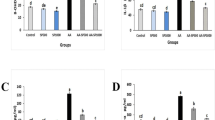Abstract
Schisandrin B (Sch B), a dibenzocyclooctadiene derivative isolated from Fructus Schisandrae, has been shown to produce antioxidant effect on rodent liver and heart. A mouse model of tert-butylhydroperoxide (t-BHP) induced cerebral toxicity was adopted for examining the antioxidant potential of Sch B in the brain. Intracerebroventricular injection of t-BHP caused a time-dependent increase in mortality rate in mice. The t-BHP toxicity was associated with an increase in the extent of cerebral lipid peroxidation and an impairment in cerebral glutathione antioxidant status, as evidenced by the abrupt decrease in reduced glutathione (GSH) level and the inhibition of Se-glutathione peroxidase activity at 5 min following t-BHP challenge. Sch B pretreatment (1 or 2 mmol/kg/day × 3) produced a dose-dependent protection against t-BHP induced mortality. The protection was associated with a decrease in the extent of lipid peroxidation and an enhancement in glutathione antioxidant status in brain tissue detectable at 5 min post t-BHP challenge, with the assessed biochemical parameters being returned to normal values at 60 min in Sch B pretreated mice at a dose of 2 mmol/kg. The ensemble of results suggests the antioxidant potential of Sch B pretreatment in protecting against cerebral oxidative stress.
Similar content being viewed by others
References
State Administration of Traditional Chinese Medicine: Advanced Textbook on Traditional Chinese Medicine and Pharmacology, vol. II. New World Press, Beijing, 1995, pp 340–361
Chen SY, Li F: A Clinical Guide to Chinese Herbs and Formulae. Churchill Livingstone, New York, 1993, pp 169
Li XY: Bioactivity of neolignans from Fructus Schizandrae. Mem Inst Oswaldo Cruz 86: 31–37, 1991
Tang W, Esienbrand G: Chinese Drugs of Plant Origin. Springer-Verlag, Berlin, 1992, pp 903–907
Ip SP, Poon M KT, Wu SS, Che CT, Ng KH, Kong YC, Ko KM: Effect of Schisandrin B on hepatic glutathione antioxidant system in mice: Protection against carbon tetrachloride toxicity. Planta Med 61: 398–401, 1995
Yim TK, Ko KM: Schisandrin B protects against myocardial ischemiareperfusion injury by enhancing myocardial glutathione antioxidant status. Mol Cell Biochem 196: 151–156, 1999
Laursen SE, Belknap JK: Intracerebroventricular injections in mice –some methodological refinements. J Pharmacol Meth 16: 355–357, 1986
Young IS, Trimble ER: Measurement of malondialdehyde in plasma by high performance liquid chromatography with fluorimetric detection. Ann Clin Biochem 28: 504–508, 1991
Reed DJ, Babson JR, Beatty PW, Brodie AE, Ellis WW, Potter JW: High-performance liquid chromatography analysis of nanomole levels of glutathione, glutathione disulfide, and related thiols and disulfides. Anal Biochem 106: 56–62, 1980
Ip SP, Ko KM: The crucial antioxidant action of schisandrin B in protecting against carbon tetrachloride hepatotoxicity in mice: A comparative study with butylated hydroxytoluene. Biochem Pharmacol 52: 1687–1683, 1996
Lawrence RA, Burk RF: Glutathione peroxidase activity in seleniumdeficient rat liver. Biochem Biophys Res Commun 71: 952–958, 1976
Godin DV, Garnett ME: Species-related variations in tissue antioxidant status – I. Differences in antioxidant enzyme profiles. Comp Biochem Physiol 103: 737–742, 1992
Warholm M, Guthenberg C, Von Bahr C, Mannervik B: Glutathione transferases from human liver. Meth Enzymol 113: 499–504, 1985
Adams JD Jr, Wang B, Klaidman LK, LeBel CP, Odunze IN, Shah D: New aspects of brain oxidative stress induced by tert-butylhydroperoxide. Free Radic Biol Med 15: 195–202, 1993
Rush GF, Gorski JR, Ripple MG, Sowinski J, Bugelski P, Hewitt WR: Organic hydroperoxide-induced lipid peroxidation and cell death in isolated hepatocytes. Toxicol Appl Pharmacol 78: 473–483, 1985
Sies H, Summer KH: Hydroperoxide-metabolizing systems in rat liver. Eur J Biochem 57: 503–512, 1975
Jocelyn JC: Oxidation of thiols. In: J.C. Jocelyn (ed). Biochemistry of the SH Group. Academic Press, New York, 1972, pp 95–115
Reed DJ: Glutathione: Toxicological implications. Ann Rev Pharmacol Toxicol 30: 603–631, 1990
Slivka A, Mytilineoce C, Cohen G: Histochemical evaluation of glutathione in brain. Brain Res 409: 275–284, 1987
Wüllner U, Seyfried J, Groscurth P, Beinroth S, Winter S, Gleichmann M, Heneka M, Loschmann PA, Schulz B, Weller M, Klockgether T: Glutathione depletion and neuronal cell death: The role of reactive oxygen intermediates and mitochondrial function. Brain Res 826: 53–62, 1999
Smith ML, Beudek G, Dahlgrer N, Roseu I, Wieloch T, Siesjo BK: Models for studying long-term recovery following forebrain ischemia in the rat. Acta Neurol Scand 69: 385–401, 1984
Ochi T: Inhibition of glutathione peroxidase by tertiary-butylhydroperoxide in cultured Chinese hamster cells and the role of cellular glutathione in the recovery of activity. Toxicology 71: 119–127, 1992
Xue JY, Liu GT, Wei HL, Pan Y: Antioxidant activity of two dibenzocyclooctene lignans on the aged and ischemic brain in rats. Free Radic Biol Med 12: 127–135, 1992
Barkats M, Millecamps S, Abrioux P, Geoffroy MC, Mallet J: Overexpression of glutathione peroxidase increases the resistance of neuronal cells to Aβ-mediated neurotoxicity. J Neurochem 75: 1438–1446, 1992
Yamaguchi T, Sano K, Takaura K et al. for the Ebselen Study Group: Evselen in acute ischemic stroke: A placebo-controlled, double-blind clinical trial. Stroke 29: 12–17, 1998
Author information
Authors and Affiliations
Rights and permissions
About this article
Cite this article
Ko, KM., Lam, B.Y. Schisandrin B protects against tert-butylhydroperoxide induced cerebral toxicity by enhancing glutathione antioxidant status in mouse brain. Mol Cell Biochem 238, 181–186 (2002). https://doi.org/10.1023/A:1019907316129
Issue Date:
DOI: https://doi.org/10.1023/A:1019907316129



